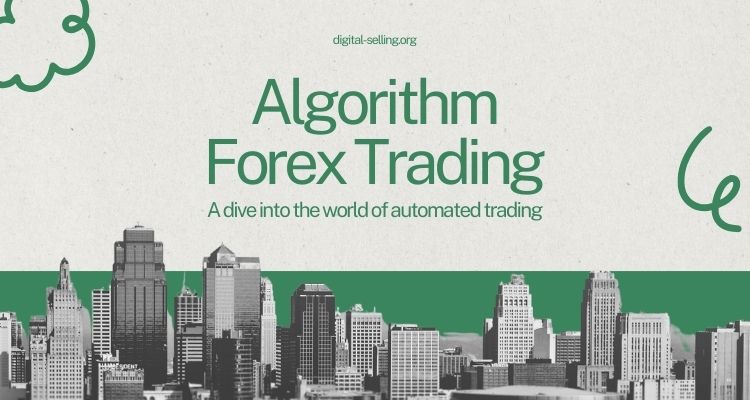If you want to make data based decisions one of the most powerful tools to use is the algorithm forex trading system.
In the fast-paced world of forex trading, where fortunes can be made or lost in the blink of an eye, traders are constantly seeking an edge. Algorithm forex trading has emerged as a powerful tool that enables traders to make data-driven decisions and execute trades automatically. So, shis article will explore the fascinating realm of algorithm forex trading, its benefits, challenges, and the key considerations for traders who are interested in harnessing its potential.
What is Algorithm Forex Trading?
Algorithm forex trading, also known as algorithmic trading or algo trading, refers to the use of computer programs or algorithms to execute trading strategies in the foreign exchange market. These algorithms are designed to analyze market data, identify trading opportunities, and execute orders with minimal human intervention. The primary goal of algorithmic trading is to increase efficiency, reduce emotional bias, and enhance trading profitability.
Benefits of Algorithm Forex Trading
- Speed and Efficiency: Algorithms can analyze market data and execute trades at speeds far beyond human capabilities. This speed advantage can be crucial in a market where prices can change rapidly.
- Eliminating Emotional Bias: One of the most significant challenges for human traders is dealing with emotions such as fear and greed. Algorithms follow predefined rules and are not influenced by emotions, leading to more disciplined trading.
- 24/5 Operation: Forex markets operate 24 hours a day, five days a week. Algorithmic trading can monitor the market and execute trades at any time, ensuring that you don’t miss opportunities during off-hours.
- Risk Management: Algorithms can incorporate risk management rules to limit potential losses. Stop-loss and take-profit orders can be executed automatically, helping traders maintain their discipline.
- Backtesting: Algorithms allow traders to test their strategies on historical data to assess their viability before applying them in a live trading environment. This can help refine and optimize strategies.
- Diversification: Algorithmic trading can simultaneously execute multiple strategies or trades across various currency pairs, providing a level of diversification that would be challenging for individual traders to achieve manually.
- Reduced Transaction Costs: Algorithmic trading can help reduce costs associated with spreads and commissions by optimizing entry and exit points.
Key Considerations for Algorithm Forex Trading
While algorithmic trading offers numerous advantages, it is not without its challenges and considerations. Here are some important factors to keep in mind:
- Algorithm Development: Developing a trading algorithm requires a strong understanding of programming, statistical analysis, and market dynamics. Traders must invest time and effort into building, testing, and fine-tuning their algorithms.
- Data Quality and Latency: The quality and timeliness of data are critical in algorithmic trading. Traders need access to reliable data sources and low-latency connections to ensure accurate decision-making.
- Over-Optimization: While backtesting is a valuable tool, traders must be cautious about over-optimizing their algorithms based on historical data. Overfitting to past market conditions can lead to poor performance in real-time trading.
- Market Volatility: Forex markets can experience extreme volatility, and algorithms may struggle to adapt to rapidly changing conditions. It’s essential to build algorithms that can handle a wide range of market scenarios.
- Risk Management: While algorithms can include risk management rules, it’s crucial for traders to monitor their systems and intervene if necessary to prevent catastrophic losses.
- Regulatory Considerations: Algorithmic trading is subject to regulatory oversight in many jurisdictions. Traders should be aware of the rules and regulations governing their trading activities.
- Continuous Monitoring: Even though algorithmic trading can operate independently, it still requires ongoing monitoring to ensure that it aligns with the trader’s goals and market conditions.
Types of Algorithm Forex Trading Strategies
There are various algorithmic trading strategies used in the forex market, including:
- Trend Following: These strategies aim to identify and capitalize on market trends. Algorithms can use various indicators to detect the direction of the trend and place trades accordingly.
- Mean Reversion: Mean reversion strategies operate on the belief that asset prices tend to revert to their average or historical mean. Algorithms monitor deviations from this mean and execute trades when they believe prices will return to it.
- Arbitrage: Arbitrage strategies seek to profit from price disparities in different forex markets or currency pairs. Algorithms can quickly identify arbitrage opportunities and execute trades to capitalize on them.
- Statistical Arbitrage: This strategy involves exploiting statistical relationships between different assets or currency pairs. In addition, algorithms analyze correlations and divergences to make trading decisions.
- Scalping: Scalping strategies involve making rapid, small trades to profit from short-term price movements. Algorithms can execute numerous trades within seconds or minutes to accumulate profits.
The Future of Algorithm Forex Trading
The future of algorithm forex trading looks promising. As technology continues to advance, algorithms will become even more sophisticated, incorporating machine learning and artificial intelligence to adapt to changing market conditions. The use of big data and high-frequency trading will likely become more prevalent, providing traders with even more tools to gain an edge in the forex market.
In conclusion, algorithm forex trading has become an integral part of the foreign exchange market. Its speed, efficiency, and ability to eliminate emotional bias make it a valuable tool for traders. However, algorithmic trading is not without challenges, and traders must invest time and effort into algorithm development and continuous monitoring. With the right approach and careful consideration of the key factors, algorithm forex trading can provide traders with a competitive advantage in the dynamic world of forex trading.




